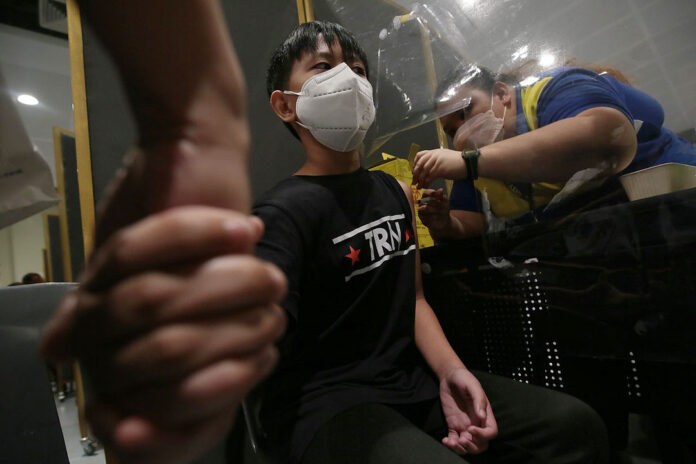By Kyle Aristophere T. Atienza, Reporter
THE PHILIPPINES remains at low risk from the coronavirus, health authorities said on Monday, as the country tightens border controls to prevent an outbreak of a new variant first detected in South Africa.
The country had an average of 896 cases daily from November 23 to 29, 34% lower than the 1,353 daily cases from Nov. 16 to 22, Alethea de Guzman, director of the Health department’s epidemiology bureau, said at a virtual news briefing.
“Nationally we are at a low risk case classification with a negative two week growth rate at -45% and we now have an average daily attack rate at 1.02 cases for every 100,000 individuals,” Ms. de Guzman said.
She said the utilization rate of the country’s health system was also at a low-risk classification.
The percentage of critical cases among confirmed admissions has plateaued “while the percentage of severe cases has started to decline starting end-October,” Ms. de Guzman said.
Health authorities on Monday reported 665 new infections — the lowest daily tally since July last year — bringing the total to 2.83 million.
The death toll hit 48,501 after 141 more patients died, while recoveries increased by 993 to 2.77 million, it said.
There were 16,289 active cases, 48.1% of which were mild, 6% were asymptomatic, 15.6% were severe, 23.82% were moderate, and 6.6% were critical.
It said 27% of intensive care units nationwide were occupied. The rate for the capital region Metro Manila was also 27%.
The Health department said 10 duplicates were removed from the tally, eight of which were reclassified as recoveries and one was relisted as a death.
The agency said 129 recoveries were reclassified as deaths. It added that 87 cases “were found to have tested negative and have been removed from the total case count.”
Two laboratories did not operate on Nov. 27, while three laboratories failed to submit data.
The Philippines has already suspended inbound flights from South Africa, Botswana, Namibia, Zimbabwe, Lesotho, Eswatini, Mozambique, Austria, Czech Republic, Hungary, The Netherlands, Switzerland, Belgium, and Italy over the Omicron variant, which authorities said has a large number of mutations. The travel ban will take effect until mid-December.
The government has also suspended a plan to welcome fully vaccinated foreign travelers who are eligible for a visa-on-entry from Dec. 1-15.
Only countries with local transmission of the new variant would be placed under the Philippine government’s red list for travel, acting Presidential Spokesman Karlo Alexei B. Nograles told a televised news briefing.
He made the clarification amid concerns about the non-inclusion of Hong Kong in the red list despite the detection of the Omicron variant there.
If an Omicron case in a country is considered “imported” and there is no local transmission, a Philippine pandemic task force has the option to retain the status of that country, Mr. Nograles said. The task force could “override” the policy if the surveillance and the genome sequencing efforts of that particular country are not competent enough, he added.
“We are actively monitoring any and all events happening in all countries, territories, and jurisdictions around the world,” he said.
Joshua L. San Pedro, a medical doctor who co-convened the Coalition for People’s Right to Health, has been urging the government to boost the country’s testing capacity and increase funding for containment measures to protect Filipinos from a potential outbreak of the new variant.
The Health department has yet to reach its ideal testing capacity, with only about 30,000 daily tests done in recent weeks, he told BusinessWorld on Sunday. Twenty-nine provinces still lack an accredited testing laboratory, while three more provinces do not have a public lab, he added.
Omicron could pose a greater threat than the Delta variant, which has been causing surges worldwide, according to the World Health Organization. “This variant has a large number of mutations, some of which are concerning,” it said on its website.
VACCINATION
Also on Monday, the Philippines began an ambitious three-day campaign to vaccinate nine million people against the coronavirus.
Pandemic authorities originally aimed to inject 15 million shots during the vaccination campaign that runs from Nov. 29 to Dec. 1.
Still, the target could be a record in a country that had struggled to inoculate its people due to vaccine hesitancy, supply issues, and various logistical hurdles.
“This is our single biggest push to fast-track vaccination and reach target of 70% population protection nationwide,” President Rodrigo R. Duterte said at a vaccination event inside a shopping mall in Antipolo City.
He said the country expects to fully vaccinate a total of 54 million Filipinos by the end of the year.
“We also aim to inoculate 80 percent of the population of minors aged 12 to 17 years and complete the booster shots for those belonging to A1, A2 and A3 sectors,” Mr. Duterte said, referring to healthcare workers, senior citizens, and persons with comorbidity.
Meanwhile, vaccine czar Carlito G. Galvez, Jr. said essential workers and indigents may also get booster shots starting Dec. 8.
The country is currently giving out additional shots to health workers, seniors, and seriously ill people.
More than 174,000 individuals have so far received top-up shots, Mr. Galvez said.
The Philippines has “more than enough” supply of vaccines to give people additional doses, he said. “We want to make use of these vaccines in the soonest possible time.”

